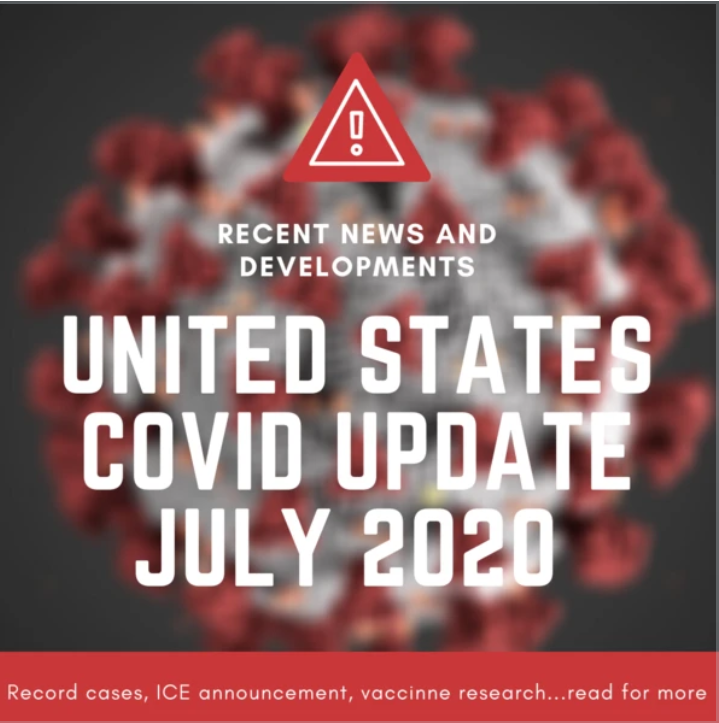
Record number of cases reached in USA COVID-19 history.
Where the Northeast was the main concern in the US at the beginning of this pandemic, the South and West are now areas of large concern where states that have reopened earlier are experiencing alarmingly high rates of new cases each day. In fact, the US is experiencing a record number of cases every day for a week in a row with approximately 60,000 new cases each day today. The government and many health experts urge the public to understand that as we enjoy and look forward to the reopening of local areas, we must keep in mind that we are still in the midst of a pandemic of a deadly virus and we must continue to be vigilant–proper face covering, with the nose and mouth covered, is still required in many places and highly recommended in others. We must continue to be mindful of our own spaces and stay 6ft apart in places that are indicated and even in public. If you would like to know more about how to stay safe according to the CDC, please refer to previous posts which summarize government health safety guidelines.

Image Source: Lancaster Online
As new cases continue to rise when it seems the initial wave of coronavirus has yet to pass, the season to consider returning to schools and campuses is fast approaching. President Trump has been eager to have schools reopen and for students to return even under the current circumstances. Parents and faculty have expressed concerns regarding this decision and it is unclear as to whether the pandemic will alleviate by the time the semester begins. It is important, as in any new reopening or public excursions, to pay special attention to keeping yourself appropriately safe from others and others from yourself. If you ever suspect any symptoms that are described by the CDC, immediately seek medical attention and be mindful of those around you (Time Magazine).
ICE announcement creates uncertainty amongst international students.
As discussed previously the decision for schools to reopen in the upcoming semester has been strongly advocated by the President. This has been a recent development well after many schools and universities in the nation have decided to conduct classes fully remotely for the upcoming fall semester, including Harvard and MIT. In light of this decision by the government, the Immigration and Customs Enforcement recently announced that international students who are currently enrolled in colleges and universities that are planning to conduct the semester remotely are being asked to leave the country or face deportation otherwise. These students will have their visas revoked or not have them issued and will not be permitted to enter the United States. Many schools are left confused and more uncertain as to what measures should be taken for their students–to reopen schools risking the health of many or to ask a majority of students to leave the country or transfer schools. Many schools, including Harvard, BU, and MIT, found this particularly challenging and have taken legal action against the government in regards to this decision (CNN).
New discoveries on the virus.
As of July 9th, the World Health Organization has presented new guidance regarding the possibility of COVID-19 becoming airborne in the form of aerosols. Aerosols have the potential to linger in the air space even after a person has left the area and can potentially infect other people who are exposed to the same air. This would include small and crowded spaces or somewhere with poor ventilation. Previously, WHO stated that COVID-19 is largely transmitted in the form of large droplets from coughs and sneezes that are too heavy to travel past 6ft and that airborne transmission is only a major concern in specific medical circumstances. However, with recent surges in cases, especially in areas that have largely reopened, such as Florida and Texas, airborne transmission is a possibility. Therefore, WHO issued a caution for people, in addition to continuing to follow the safety guidelines issued by the CDC and WHO, to avoid enclosed spaces that are crowded or experiences poor ventilation (WHO).
Is the new vaccine on the way?

Image Source: Global News
It was announced towards the beginning of this pandemic that a vaccine would hopefully be developed by early 2021. According to leading physicians, like Dr. Rick Malley from Boston Children’s Hospital, it will be ambitious and difficult to reach that point. To put a scale to this, the fastest a vaccine has ever been developed was for mumps with the span of 4 years. COVID-19 is fairly complex and has proven to take different forms in the past few months. In vaccine development, there are several important stages to complete before moving forward to providing doses to many populations. This includes, but not limited to, the multitude of steps to ensure that the vaccine is safe long-term for humans, the efficiency of protecting against the virus, and whether enough vaccines can be distributed amongst the many populations that need it. Currently, there are teams of very capable scientists behind the composition of vaccines with three different versions in the works. Whether they will be viable by early 2021 is still unclear. However, until we reach that point, it is important, as reiterated in this article and past articles, to follow safety guidelines to protect yourself and your community (Boston Children’s Hospital).
by Emin Lee
References:
https://www.nytimes.com/2020/07/09/world/coronavirus-updates.html
https://www.cdc.gov/coronavirus/2019-ncov/whats-new-all.html
https://www.livescience.com/who-covid-19-airborne-transmission-update.html
